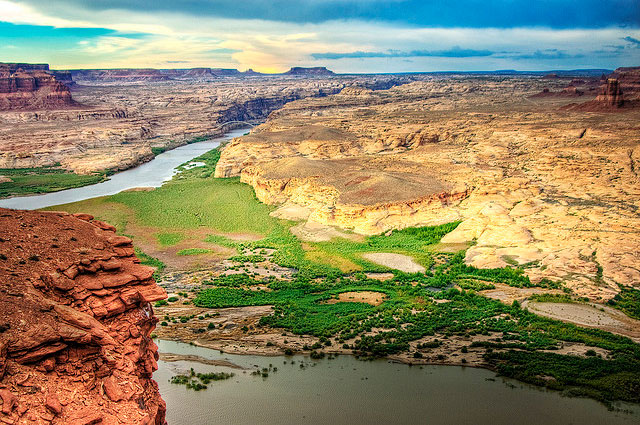November 30, 2012
Air Date: November 30, 2012
FULL SHOW
SEGMENTS

The Obama Administration Axes the CIA’s Climate Change and National Security Center
View the page for this story
As one of the hottest years on record comes to a close, the CIA has decided to shutter its Center on Climate Change and Security. Joe Romm, senior fellow at the Center for American Progress, discusses the closure of the center and the future of environmental security with host Steve Curwood. (06:00)
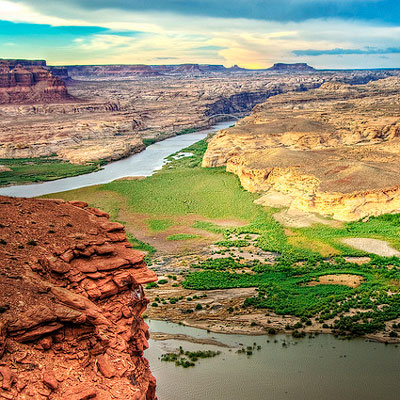
New Rules for Sharing the Shrinking Colorado River
View the page for this story
The shrinking Colorado River is a critical water source for thirty million people and a source of friction between Mexico and the United States. Now,the two countries have signed what they hope will be a better deal for them and the river. Host Steve Curwood talks with Carlos De La Parra, Professor of Urban and Environmental Studies at the College of the Northern Frontier in Tijuana, Mexico who advised the Mexican Commissioner in the Colorado River negotiations. (05:55)
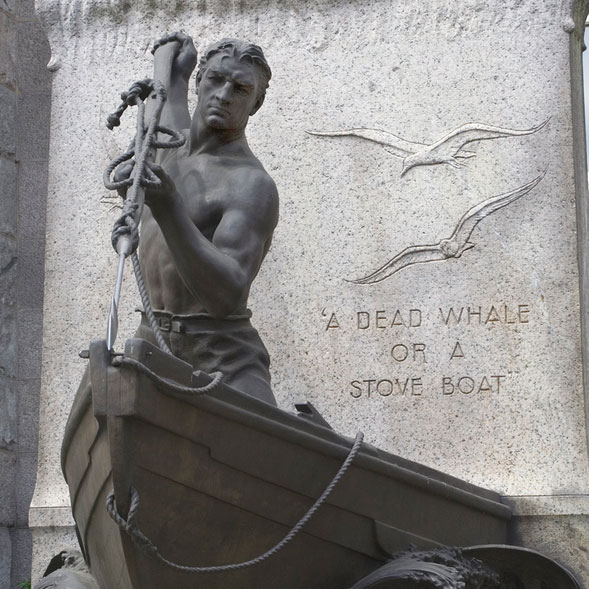
Power Shift- New Energy for New Bedford
/ Naomi ArenbergView the page for this story
The Massachusetts fishing port of New Bedford was the heart of the whaling industry in the 19th century, and called "the city that lit the world". That industry has gone, and so has much of New Bedford's prosperity. But city managers see a new energy future, thanks to energy efficiency, renewables and offshore wind. Naomi Arenberg reports. (09:15)
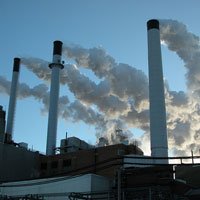
The NAACP Cites Discriminatory Impacts from Coal-Fired Power Plants
View the page for this story
The National Association for the Advancement of Colored People has released a report that documents the disproportionate health impacts of coal-fired power plants on low-income communities of color. The director of the NAACP’s Climate Justice Initiative Jacqui Patterson joins host Steve Curwood to discuss environmental justice, and coal pollution. (06:50)

Science Note: Monkey Mind Control
/ Christy PereraView the page for this story
For years scientists have attempted to find effective treatments for mental disorders like depression and addiction. Thanks to new research using optogenetics that controls monkeys’ motions, there may be a light at the end of the tunnel. Christy Perera reports. (01:50)
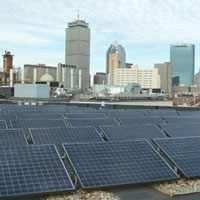
Power Shift - Northeastern University Cited As America’s Greenest College
/ Bobby BascombView the page for this story
Colleges and universities across the country are investing in building efficiency and renewable energy to save money and the environment. Living on Earth’s Bobby Bascomb reports from Boston’s Northeastern University that small changes can add up to big savings. (11:55)

The Place Where You Live
/ Wong Yoo-ChongView the page for this story
In collaboration with Orion magazine writer Wong Yoo-Chong shares his thoughts and feelings about the place he now calls home in the rolling green hills of Northern California. (03:30)
This week's EarthEar selection
listen /
download
An Inuit Throat Song called The River.
Show Credits and Funders
Show Transcript
HOST: Steve Curwood
GUESTS: Joe Romm, Carlos De La Parra, Jacqui Patterson
REPORTERS: Naomi Arenberg, Christy Perera, Bobby Bascomb, Wong Yoo-Chong
[THEME]
CURWOOD: From Public Radio International - this is Living on Earth. I'm Steve Curwood. Scientists at the UN climate meeting say there's evidence that global warming is accelerating - but the news may not have reached the CIA. It's killed its center that studies climate change and national security.
ROMM: If the intelligence apparatus of this country, with its 75 billion dollar budget, can't have a small center to study one of the gravest threats facing the world, that's a pretty sad state of affairs.
CURWOOD: Also - the city that lit the world in the 19th century is using modern technology to solarize its citizens.
RAMOS: We look at housing placements. We look at the best houses, and we’ll actually identify those homes and go knock on the door o’people and say, “we’ve been looking at your home on google, excuse us. You have a perfect roof. You’re in a perfect position. We would like you to consider solar.
CURWOOD: We'll have that story and another visit the place where you live this week, on Living on Earth. Stick Around!
[THEME]
ANNOUNCER: Support for Living on Earth comes from Stonyfield Farm.
The Obama Administration Axes the CIA’s Climate Change and National Security Center

CURWOOD: From the Jennifer and Ted Stanley Studios in Boston, this is living on Earth. I'm Steve Curwood. The annual U.N. climate talks are underway in Doha, as delegations from around the world negotiate potential solutions to the global climate crisis. It will be another week before it is clear if meaningful progress has been made or not.
But scientists say the world isn’t waiting for humans to act. One of the more startling scientific reports presented at Doha — based, so far, on preliminary data – suggests that emissions from the melting Arctic are heading for a tipping point that could lead to runaway warming.
In the meantime, without fanfare, the Obama Administration has recently axed the Center on Climate Change and National Security at the Central Intelligence Agency. Joe Romm is a Senior Fellow at the Center for American Progress who watches climate issues closely - and he joins us to discuss this spooky business. Hello there!
ROMM: Howdy!
CURWOOD: Now we understand that the CIA has shut down its center for climate change and security – why did they have the center in the first place, do you think?
ROMM: Well, there has been increasing awareness in the intelligence community and the Pentagon that global warming and climate change was going to have an impact on US national security interests. Whether it is military bases that are seeing sea level rise or countries that are subject to worse droughts and famines, so, you know, I think many countries around the world had come to the view that climate change was going to have a big impact on security.
CURWOOD: Why shut this unit down now?
ROMM: Apparently the unit didn’t have much support when Panetta left and General Petraeus took over at the CIA. Petraeus was very focused on terrorism, and there’s a lot of congressional Republicans, who, you know, deny climate science and therefore attack any action by the federal government to study climate change and its impacts.
CURWOOD: Some suggest that the CIA shutting down its Center for Climate Change and Security is a budget matter. What’s your analysis?
ROMM: Well, I think that everyone knows that budgets are under duress. We have this fiscal cliff, in all likelihood, discretionary spending, even for intelligence, is going to be cut. Some were saying that the CIA was trying to make nice with Congressional Republicans and not continue this center that kind of annoyed them.
I hope that’s not the case, because, this is a matter of pretty basic science and it would be a shame if our intelligence organization, whose job is to sift through the facts and be completely separate from ideological spin, it would be a shame if they were getting pressured to not look at science and facts.
CURWOOD: Greenwire published a statement that they attributed to Senator John Barrasso, a Republican from Wyoming, saying, “Closing the Climate Change Center a the CIA is the right decision. It’s critically important for the CIA to focus its resources on terrorism and keeping Americans safe.”
ROMM: The entire US Intelligence budget is $75 billion dollars, so I think there is clearly money available to be looking at these longer-term global threats like climate change. But you know, after seeing what hurricane Sandy did to New York and New Jersey, and imagine how these super storms are going to be like when they hit poorer countries that don’t have the kinds of resources that we do – I don’t think that anyone can say that we should ignore the threat of climate change.
CURWOOD: To what extent, Joe Romm, do you think that the United States recognizes climate change as a security threat?

Joe Romm of the Center for American Progress (Photo: Jonah Koch)
ROMM: I think that there’s no question that the security establishment understands that climate change is a threat and a growing one. You know, the World Bank, for instance, just issued a report saying we are headed towards a series of pretty catastrophic impacts if we don’t reverse carbon pollution trends. And the Pentagon has certainly looked at the impact of sea level rise and drought.
Yeah, I think the security establishment is aware of it, but until the federal government, until there is broad acceptance by not just Democrats, but conservatives and the like, that one can start publicly talking about climate change and the threat that it poses, it’s always going to be hamstrung in how much it can do.
CURWOOD: Well, how much though can the Democrats do? I mean, how much will the White House push a new CIA Director – because with the departure of General Petraeus from the CIA, there’s a job opening there – how much will the White House push this new director to consider climate issues, bring back, perhaps the Center for Climate Issues at the Central Intelligence Agency?
ROMM: Well, it’s a good question. These things are always dependent on the individual involved. Clearly the number one job of the Central Intelligence Agency has got to be to prevent terrorist attacks on the US and its national interests around the world. But, as even Barrasso said, the goal of the intelligence apparatus is to help make Americans safer and more secure. And, since global warming is clearly a growing threat to our security, both directly and through how it affects countries that we have an interest in, we need to focus the CIA’s and the Pentagon’s thinkers on climate change.
CURWOOD: Final word here, Joe… closing the center – a mistake?
ROMM: Closing the center was absolutely a mistake. If the intelligence apparatus in this country with its $75 billion dollar budget can’t have a small center to study one of the gravest threats facing the world, that’s a pretty sad state of affairs.
CURWOOD: Joe Romm is the Senior Fellow at the Center for American Progress in Washington, thanks so much, Joe!
ROMM: Thanks for having me!
Related links:
- Original CIA 2009 statement announcing the creation of its Center on Climate Change and National Security
- Greenwire report on closure
[MUSIC: Marc Ribot “Todo El mundo Es Kitsch” from Ceramic Dog (Pi Records 2010).]
New Rules for Sharing the Shrinking Colorado River

The now-dry Colorado River delta branches into the Baja/Sonoran Desert just 5 miles north of the Sea of Cortez, Mexico. (Photo: Peter McBride, U.S. Geological Survey)
CURWOOD: The once mighty Colorado River frequently dries up long before it reaches the sea just south of the Mexico-US border. The U.S. captures most of the water, taking ten times as much as Mexico. On both sides of the border, millions depend on the shrinking river as a critical water source.
Well, now Mexico and the U.S. have signed an amendment to their nearly 70-year-old water pact that shares the water a bit more equitably. To explain the details, we turn to Carlos De La Parra. He's Professor of Urban and Environmental Studies at El Colegio de la Frontera Norte - the College of the Northern Frontier - in Tijuana, Mexico, and advised the Mexican Commissioner in the Colorado River negotiations. Welcome to Living on Earth!
DE LA PARRA: Hello how are you?
CURWOOD: Good. Now, what’s in this new pact between the United States and Mexico?
DE LA PARRA: Well, it’s an agreement that there are things that both countries see eye-to-eye. One is the issue of a delta that needs to be restored, and the second is that equity must prevail in the new agreement, and that means that if there’s a shortage of supply then everybody gets a little less and if there is a surplus then everybody gets a little more. The third element is that both countries see that there’s a benefit for investing in infrastructure to increase efficiency, conserve water and therefore to have more water to go around.
CURWOOD: So, when the International Water Agreement was put together back in 1944, as I understand it, the US gets 15 million acre feet every year off the Colorado River, and Mexico gets just 1.5 million acres, one tenth of the US amount. How fair is that?
DE LA PARRA: Well, that’s a good question and it depends on who you ask. Ask folks on the US side, there are some that say that Mexico got too much. But ask some who are south of the border and we might say that we got too little, or that quantity is not the issue but quality. And so it really is something very relative.
CURWOOD: What happens to the water promised to Mexico in the new arrangement?
DE LA PARRA: It’s still there, but the treaty itself says that in cases of extreme drought, both countries would have to reduce their allocation. Fortunately, the agreement also says that investments that will take place starting next year will conserve enough water so that the folks that are suffering because of less allocation will have some water saved up to counteract that shortage. In times when there’s more water, everybody, including Mexico, now gets a surplus.
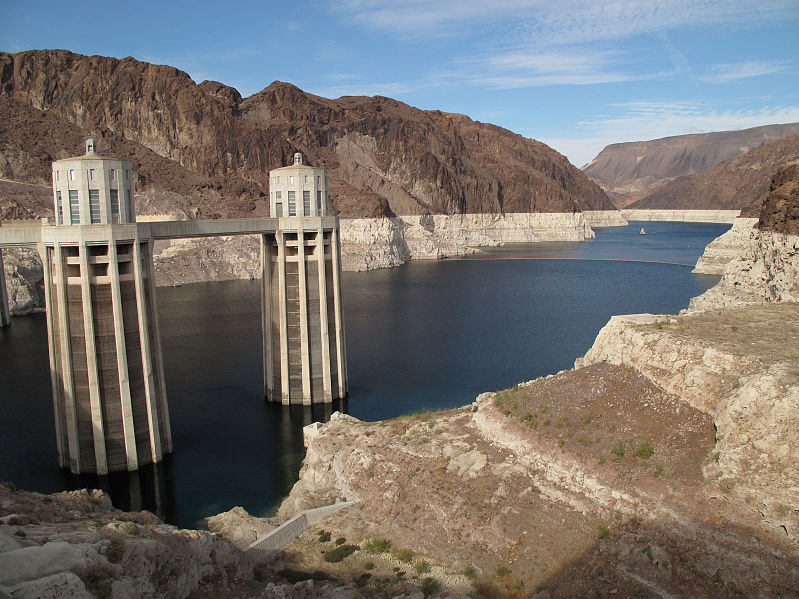
Lake Mead, as seen from the Arizona side of Hoover Dam showing the white “bathtub ring” from low water levels during drought. (Photo: wikipedia.org)
CURWOOD: Where will the surplus be held for Mexico?
DE LA PARRA: In Lake Mead. Mexico doesn’t have the topography or the geology doesn’t allow Mexico to have a storage basin in Mexican territory. So now Lake Mead will also have an additional volume of water stored there that will be labeled, ‘this is Mexican water.’
CURWOOD: How much does the new agreement focus on conservation of the Colorado River?
DE LA PARRA: You know, conservation is something that has been sort of flying under the radar of both countries. There’s obviously ways to improve water efficiencies in agricultural areas both countries, both in California and in Baja California and the Mexicali Valley, but there’s also a lot of efficiencies in conservation that can be done in cities. So, at least this new agreement, it’s a proactive approach to what’s going to happen when there’s actually a greater shortage of water, if indeed that happens. It’s now become one… a part of the mix, which is a lot to say for 21st century water management.
CURWOOD: Talk to me about the Delta of the Colorado River when it comes into the Sea of Cortez there between Baja California and the mainland of Mexico.
DE LA PARRA: The wetlands of the Colorado River are about 90 percent gone. They were desiccated over the course of a century. And this agreement is not an effort to restore this delta, more than trying to make it a viable habitat for wildlife, migratory birds, resident birds, and there are some endangered species that are suffering because of lack of habitat.
There’s also some impact, we don’t know how much, but there’s also some impact on wildlife in the marine ecosystem. So it’s actually trying to patch up something that we haven’t been doing for at least 50 years, and then starting to monitor and see what happens. The idea… the utopia of turning back the clock… is probably not in the minds of the folks that arranged for this agreement.
CURWOOD: So, science is telling us that climate change is upon us and could decrease the Colorado River’s flow by up to 20 percent over the next 40 years. How does the pact address this looming problem?
DE LA PARRA: Well, keep in mind that this agreement will only be enforced for five years.
CURWOOD: OK.
DE LA PARRA: It’s actually a pilot period that will allow us to start examining how good we are in sharing investments for conservation and contributing jointly to the restoration of wetlands and analyzing future data that will be required, so that in the future, when those 40 years come, we’re not going to be fighting about what triggers the shortage, or how much is required so that we can have what is called an extreme drought.
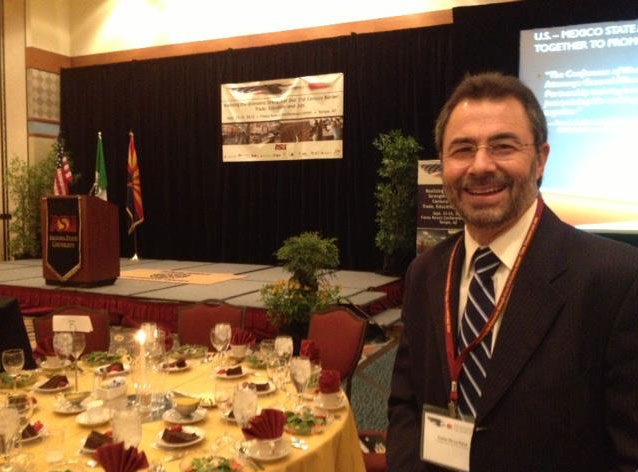
Carlos De La Parra (Photo: Carlos De La Parra)
CURWOOD: In the West they say: Whiskey is for drinkin’, water is for fightin’.
DE LA PARRA: (Laughs.) I wonder what tequila is for? Maybe for celebrating that water isn’t for fighting?
CURWOOD: (Laughs.) Well, thank you so much for taking this time with me today!
DE LA PARRA: No, thank you very much for the opportunity.
CURWOOD: Carlos de la Parra teaches urban and environmental studies at El Colegio de la Frontera Norte.
Related links:
- More about Carlos De La Parra
- Press release from the U.S. Department of Interior
- International Boundary and Water Commission’s press release
[MUSIC: Smoke City/Various Artists “Numbers” from Brasil 2 Mil – The Soul Of Bass A Nova (Six Degrees Records 1995).]
CURWOOD: Just ahead – Thar she blows! How the city at the heart of the lighting business in the 19th century is getting a sustainable energy make-over - stay tuned to Living on Earth!
[CUTAWAY MUSIC: Jimi Hendrix: “New Rising Sun” from West Coast Seattle Boy: The Jimi Hendrix Anthology (Sony Music 2010)
Happy 70th Birthday 11/27/42 – 9/18/70.]
Power Shift- New Energy for New Bedford

Wind turbines like these are proposed for the Cape Wind project in Massachusetts. (Siemens)
CURWOOD: It’s Living on Earth, I'm Steve Curwood. In Hermann Melville's classic tale of a whale, the narrator – called Ishmael – boards a schooner in the port at the heart of the whaling industry, New Bedford, Massachusetts. New Bedford was "the city that lit the world," back when whale oil was the chief fuel for lamps. Those days – and most of the whales – are long gone, but New Bedford has ambitions for a new and more sustainable energy future, as reporter Naomi Arenberg discovered on a recent visit.
[HARBOR SOUNDS: GULLS AND BOAT NOISES]
ARENBERG: If you walk up the hill from the Port of New Bedford, through the cobblestoned streets of the downtown area, you’ll see some of the same buildings that Herman Melville described in his 19th century novels, but there’s a lot of 21st century, “green” change in New Bedford as well, as city officials are developing a model for environmental responsibility that they say could be copied all over the U.S.
MITCHELL: When I took office in January of this year, I thought it was important to set a tone about conservation and sustainability, and one way to do that was to continue the retrofit program that has been started by the previous administration.
ARENBERG: Jon Mitchell is Mayor of New Bedford. He’s continuing programs that the previous administration started three years ago. Federal stimulus dollars funded a new department, the Energy Office, which undertook energy assessments and retro-fitting in homes and municipal buildings.
MITCHELL: This is all with an effort, really, to save folks in the city money on energy, and we have a very needy population here. We have about 20 percent of our population, unfortunately, lives under the poverty line, and so every nickel for them counts.
ARENBERG: Poverty is key to the city’s environmental initiatives. The wealthy whaling captains and cotton mill owners -- the ones who built imposing homes and large, public structures -- they’re gone. Over the last half-century, the city’s population has shrunk by about a quarter, and unemployment has remained high. A new, city wide program aims to lower energy costs, create jobs, reduce carbon emissions, and help build community. Ken Ramos is the Outreach Coordinator for New Bedford Energy Now.
RAMOS: It’s really about all the people that I knew, just being able to call them up and for them to know me, and could trust me, that if I said “Free audits,” ya’ know, they would believe me.
ARENBERG: Ramos is known as a community organizer and electrician. Now he’s reaching out to all residents, both owners and renters, through numerous community organizations and schools, to make sure that everyone knows about energy audits, cost-free, through the state’s, Mass Save program. Adrienne Wilkins is Ken’s assistant.
WILKINS: There is no movement without our community’s involvement. And knowing someone for 30, 40, 50, 60 (How old are you Ken, 22??) 70 years is it’s so important because without that people are a little hesitant. You know, they want to know who you are, where you’re from. There is no outreach without the relationship to the community.

New Bedford, MA has a long maritime history. (Bigstockphoto.com)
ARENBERG: Mass Save offers every household $2,000 worth of inspectional services and improvements – air-sealing the home, insulating the hot water heater and attic, and replacing incandescent lamps with compact fluorescent bulbs. And local 16 - 24 year olds, who've dropped out of school, are being trained to do the work.
[SOUNDS OF YOUTH BUILD OFFICE]
WILLIAMS: OK, alright. Just gimme a… have a seat.
ARENBERG: Gloria Williams is director of New Bedford’s YouthBuild program.
WILLIAMS: We have construction training. We have weatherization training. Several years ago YouthBuilds across the country, and particularly here in New Bedford, we’re experiencing funding losses and secondly our labor market is not really that strong for young people, so we’re trying to figure out ways we could increase job opportunities for graduates of the YouthBuild program. And at that time, “green” was on a new wave… so we decided to do weatherization as a service in YouthBuild.
ARENBERG: Her graduates earn fifteen dollars an hour as contractors for Mass Save, high wages for this region. But these days, business is down, and the program is running in the red. That’s unfortunate in a city with over 75-percent youth unemployment, and YouthBuild is likely to cut this program. But Ken Ramos, of New Bedford Energy Now, is upbeat. He sees a bright spot in the city’s solar outreach efforts, with current technology as an important tool.
RAMOS: Oh, we use Google Earth all the time. Our contractors use Google to go around and identify potential sites for solar. We look at housing placements. We look at the best houses, and we’ll actually identify those homes and go knock on a door of people and say, “We’ve been looking at your home on Google, excuse us. You have a perfect roof. You’re in a perfect position. We would like to you to consider solar.”
ARENBERG: And solar installation can be free for New Bedford residents. It works this way – the city partners with a privately-owned, national company, Real Goods Solar, which installs the arrays, at no cost, on any roof with clear, southern exposure. Real Goods owns the energy produced, and the solar array, for 20 years while the resident buys energy from Real Goods at a fixed price, below the average rate. Then, after two decades, the solar installation will belong to the building owner.
So far, only three homeowners have gone solar with this program, but two more installations are pending, and residents are signing up for solar evaluations. Public housing is going green, too. After retrofitting all of its 516 buildings, the housing authority outfitted 24 with photovoltaic cells last year. And the city's municipal buildings are becoming energy efficient as well, thanks to Scott Durkee, the city’s energy director, who was recovering from a cold when I met him. During his first few years in town, his office accomplished a lot, but there were problems.
DURKEE: When it came to the solar and really expanding these programs, because I was an outsider, a lot of roadblocks. When Ron took me under his wing, these doors have now opened and now you see the solar program really move forward.
ARENBERG: “Ron” is the city’s Commissioner of Infrastructure, Ron Labelle. He shares Scott’s agenda.
LABELLE: My electric bill in the city is roughly four and a half million dollars. When I say the waste water collection system, that’s a treatment plant and it’s also pumping stations, so it’s a large mechanical operation. We have over 33 pumping stations citywide. So I became familiar with Scott Durkee and his program, and we started looking at solar. This building that we’re in right now, on a sunny day, our meters are turning backwards ‘cuz we produce more energy than we use… so we’re making money on this. It’s not a bad deal.
[HARBOR SOUNDS: GULLS AND BOAT NOISES]
ARENBERG: Back at the harbor, some of the fleet of 300 fishing boats are preparing to go to sea. Within a couple of months, they’ll be plugging into electric stations at the pier, rather than running their dirty diesel engines to cool the catch or heat the cabin. And the harbor is set for a new green industry, as the nation’s first staging ground for wind farms, a project just approved by the E-P-A. Ron Labelle again.
LABELLE: This will be the staging area for all of the materials that are gonna be shipped into New Bedford, to be shipped out into Buzzard’s Bay to build that Cape Wind Project. There’s a lay-down area for all of the impellors that come in that are 180-feet long, so everything can be brought in by rail, put on ships, and brought out for the Cape Wind Project.
ARENBERG: City Energy director Scott Durkee is equally enthusiastic about the port's future in wind.
DURKEE: It’s not just Cape Wind. New Bedford now will be the deployment of any offshore wind development in the Northeast. It’s one of the greatest economic benefits for the city in probably the last 50 years. And it’s truly exciting. You’ve got the foundation of the short sea shipping with the potential of the future of this country with wind, and we’re at the heart of it.
ARENBERG: And Scott Durkee says this is just part and parcel of New Bedford’s focus on new energy.
DURKEE: The goal was to tie what we did with the history and pride of this city, and the cultural pride in this location is unbelievable. They lit the world. At one point they were the first energy capital of the world. That’s huge! And what we said is, in the past we lit the world. Going forward, we’re gonna sustain it. We’re gonna teach how to do the right things. We’re not gonna generate to light the world ever again. Now let’s show ’em how to do it right, which is what we’re all doing together, trying to build that model that you can hand off – that incorporates everything.
ARENBERG: If New Bedford can once again provide a guiding light, then perhaps other communities will follow into a green energy future. For Living on Earth, I'm Naomi Arenberg in New Bedford, Massachusetts.
Related links:
- Mass Save
- New Bedford Energy Now
- Youth Build New Bedford
[MUSIC: Neil Young “Driftin Back” from Psychedelic Pill (Reprise records 2012).]
The NAACP Cites Discriminatory Impacts from Coal-Fired Power Plants

Crawford Power Plant in Chicago shut down in August 2012 after years of protests. (Photo: University of Chicago)
CURWOOD: Coal-fired power plants can produce dangerous levels of air pollution, and according to a new report published by the National Association for the Advancement of Colored People, low income communities of color are disproportionately affected.
The report is based on a US study by economist Adrian Wilson at the University of Massachusetts at Amherst, and sponsored by the NAACP, Little Village Environmental Justice Organization, and the Indigenous Environmental Network. Joining us now to discuss the findings is Jacqui Patterson, director of the Climate Justice Initiative at the NAACP. Welcome to Living on Earth!
PATTERSON: Thank you - it's good to be here!
CURWOOD: For this report, you looked at all 378 coal fired power plants, the big ones, I guess, over 100 megawatts, right?
PATTERSON: Exactly, yes.
CURWOOD: And with did you find?
PATTERSON: We found that overall coal-fired power plants are not only located disproportionately located in low income communities, but they’re also disproportionately located in communities of color – and not necessarily low-income communities of color, but communities of color in and of themselves. It’s not always that they’re being built in these communities – often, the plants are already there and the communities come later.
And part of the issue there is that the property values are lower in areas where these toxic facilities are, and in fact one recent study I read said that they’re at least 15 percent lower. So, when you’re talking about low-income communities or low-wealth communities, those are the areas that they can afford to buy into. And sometimes there is that political piece, there’s a lack of representation of the communities that are being host to the plants in the places that are making the decisions about the siting of these plants. So that is happening more often than not in communities of color.
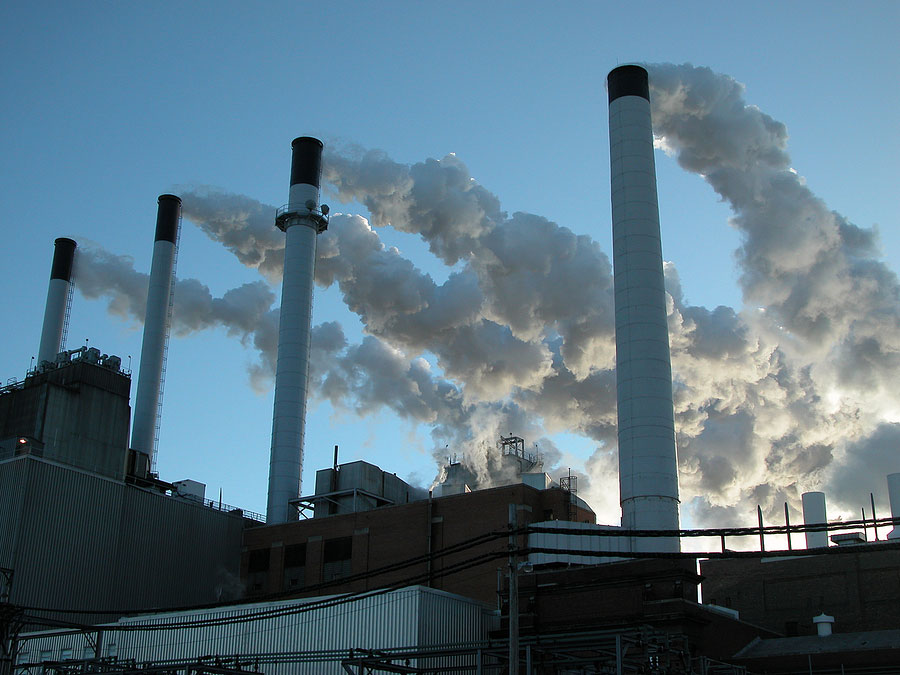
Coal-fired pollution (photograph: bigstockphoto.com)
CURWOOD: Now, you went through and gave grades to each of the 378 coal fired power plants in the US. How many did you flunk?
PATTERSON: So, 75 got an F score. A little over 100 got a D or an F, we consider both of those to be failing. A large number of the failing plants were in the Midwest, particularly in Illinois, Michigan, Ohio, Indiana… some of the ones that received the worst, worst, worst, worst scores were the Fisk and Crawford plants which were fortunately, in Chicago, have been closed since we did our research, they closed this year.
Lakeshore Plant in Cleveland is still operational and also got a failing score. Our ranking ranked them both on sulfur dioxide emission levels, nitrous oxide emissions, proximity to people in terms of population densities around the plant, the proportion of people who are of color, and the proportion of people who are low-income based on that we ranked all 378.
CURWOOD: What are the negative health impacts felt by people living around these power plants?
PATTERSON: Some of the toxins that come from these plants such as sulfur dioxide and nitrogen oxide, are tied with various respiratory illnesses, from exacerbating asthma attacks, to actually being tied to lung cancer. Mercury has been tied to birth defects, lead has been tied to learning difficulties including attention deficit disorder and so forth.
So, we can’t really absolutely say that this plant causes this person’s asthma or that, but you can say that in areas where these plants are in, you can track higher concentration of certain types of illnesses, but that really is something that universities have to look at, and so we’re really encouraging our branches to partner with universities in their area to do that kind of analysis.
CURWOOD: How aware are people living in these communities of the health impacts of coal fired power plant pollution?
PATTERSON: So, we actually went out and started to speak with these communities to say: Ok, do you have a sense of this coal-fired power plant in your backyard and do you understand what the connections might be to any illnesses that you find…. And you… really across the board: A) people weren’t really aware of the presence of the plant… other than places like Chicago where there’s actually activism, there has been for 10 years around the plant, you might see awareness, but places like New Albany, in Indiana for example, we visited with several families.
One person knew about the plant because her father worked in the plant, she hadn’t heard at all about any particular tie to any illnesses, but she did say that her father died of cancer that they thought potentially had started in his lungs, but he had never smoked a day in his life. And another person we met with there, again, didn’t know of any potential health impacts of that plant, but he lived a mile from the plant and his wife died of lung cancer, and again, had never smoked a day in her life.
So, we found a lot of those types of stories where we would got to a community and they’d talk about how half the people in their church were on respirators or half the children in their schools had asthma, but again, never really tied it to a coal plant until we started to have some of these conversations around it. So, they’ve tied it to their quality of life… not being able to hang up their laundry because soot would cover their laundry, or not being able to wash their car because soot would be all over their car. There might be some level of awareness, but I would say more times than not there really wasn’t.
CURWOOD: How successful have been the attempts to close down some of these plants?
PATTERSON: Across the board, folks have… I mean, in the last few years, various activists around the country, have shut down, I think, I believe about 100 plants, but either shut down or slated for closure over the next couple of years. So, certainly between activist’s action at the community level, and recognition on the part of the federal government of the need to regulate pollution from these plants, so the passage or the implementation of the Mercury and Air Toxics Rule that regulates some of the very toxins we talked about earlier, they’re starting to recognize the relationships between these plants and our environment. And so, in those places, the community activism there is definitely a success in shutting them down.
CURWOOD: Right now you’re in Doha for the climate negotiations, the UN Climate negotiations, my question is what role do you think the environmental justice movement should play in the effort to slow climate disruption.
PATTERSON: Climate change unfortunately disproportionately impacts certain communities. Definitely low-income communities and communities of color as well. So I think the role and the voice of communities that are so affected by this should be in the forefront in terms of talking about solutions and talking about our imperative to act on the most aggressive forms of that solution. And we really have to be a lot smarter in making sure those communities are at the table to bring that knowledge as well as to bring the passion borne out of the fact that it’s their very survival that’s at stake.
CURWOOD: Jacqui Patterson is Director of the Climate Justice Initiative at the National Association for the Advancement of Colored People. Thank you for joining us today!
PATTERSON: Thank you, it was a pleasure.
Related links:
- NAACP Report: Coal Blooded, Putting Profits Before People
- NAACP Report Summary on Disparate Impact of Coal-Fired Power Plants
[MUSIC: Jimi Hendrix “Young /Hendrix Jam” from West Coast Seattle Boy (Sony Music 2010).]
CURWOOD: Coming up… the greenest campus in America and how it makes efficiency pay. Keep listening to Living on Earth!
[CUTAWAY MUSIC: Jimi Hendrix: “Castles Made Of Sand” from West Coast Seattle Boy: The Jimi Hendrix Anthology (Sony Music 2010).]
ANNOUNCER: Funding for Living on Earth comes from the Grantham Foundation for the protection of the environment, supporting strategic communications and collaboration in solving the world’s most pressing environmental problems. The Gordon and Betty Moore Foundation. The Kendeda Fund, furthering the values that contribute to a healthy planet. And Gilman Ordway, for coverage of conservation and environmental change. This is PRI, Public Radio International.
CURWOOD: It's Living On Earth, I'm Steve Curwood. Coming up: Another visit to the place where you live… or find your inspiration. But first, this Note on Emerging Science from Christy Perera.
[SCIENCE NOTE THEME]
Science Note: Monkey Mind Control

Rhesus Monkeys are often used for laboratory experiments.
PERERA: Neurological conditions, such as addiction and depression, are difficult to treat successfully. But research suggests there may be a new tool for combatting such disorders, and we have monkey mind control to thank.
Researchers at Massachusetts General Hospital have been experimenting with optogenetics, a methodology that targets neurons in order to control animal behavior. Using optogenetics, these scientists found that they can direct monkey behavior by showing them a series of blue light pulses. These flashes activate specific brain cells that cause the monkeys to move their eyes. This is the first time this method has been shown to alter behavior in monkeys.
Optogenetics works by inserting light-sensitive genes into neurons to make them responsive to light. This experiment targeted neurons that control the monkeys' eye movements. The scientists were able to activate the neurons and monitor the effects with functional magnetic resonance imaging, or fMRI. Once activated, the neurons fired, and caused the monkeys to subtly move their eyes.
Scientists hope this research will help them gain greater insight into how human brains control behavior. Because optogenetics can target very specific types of cells, it offers special promise for disorders that affect discrete areas of the brain, such as Parkinson's disease, addiction and depression.
Researchers hope that ultimately these findings will enable them to see the light and find successful treatments for these conditions. That's this week's Note on Emerging Science, I'm Christy Perera.
Related link:
Article about the finding on Neuroscience News
[SCIENCE NOTE THEME]
Power Shift - Northeastern University Cited As America’s Greenest College
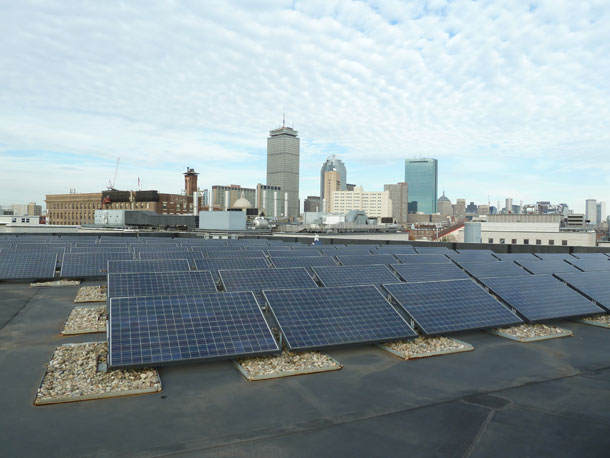
Northeastern's 18-year old experimental solar array. (Photo: Steve Curwood)
CURWOOD: Northeastern University in Boston is the greenest college in America.
That's according to the Green Metric Ranking of World Universities, and worldwide Northeastern ranks only just below the University of Nottingham in the UK. Northeastern’s scores for energy efficiency and climate protection in 2011 helped it beat out all other colleges, including the University of Connecticut, the University of California at Berkeley and UCLA in the world competition conducted by the University of Indonesia.
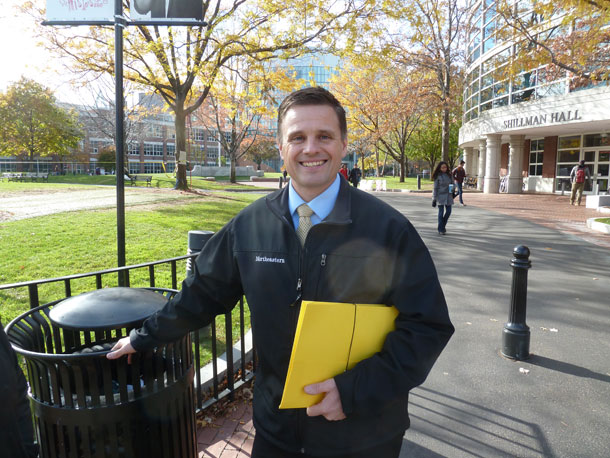
Joe Ranahan is Energy Manager at Northeastern University. (Photo: Steve Curwood)
Living On Earth’s Bobby Bascomb took a visit to the Northeastern campus and has this story of how they have been able to score with efficiency.
BASCOMB: Northeastern University sits right in downtown Boston between Symphony Hall and the Museum of Fine Arts. I met Joe Ranahan, the energy manager for the university, next to the Ruggles subway stop right outside Shillman Hall. He greeted me on a wide green lawn, but it didn't always look this way.
RANAHAN: There used to be a highway that went through where the Ruggles station is. Now it’s a pretty open and green space where before it was a dirt parking lot and thousands and thousands of cars.
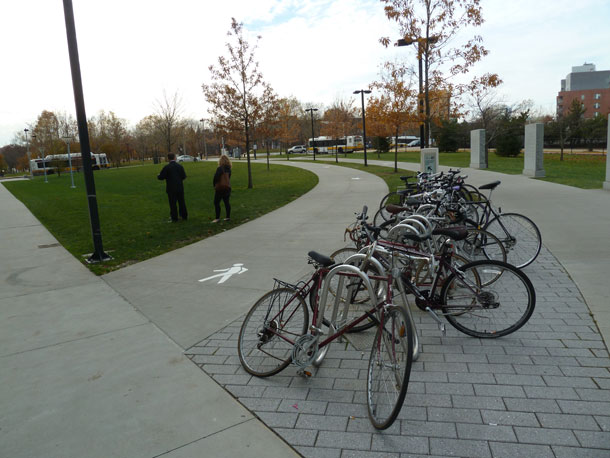
A green lawn and bike racks now occupy what was once a massive parking lot at Northeastern University. (Photo: Steve Curwood)
BASCOMB: Instead of paving the parking lot and building expensive garages the University planted grass and focused their development on public transportation. The school is now within walking distance of several bus routes, 5 subway stops, and is part of a metro bike share program.
RANAHAN: The carbon footprint has been reduced by a tremendous amount.
BASCOMB: And Northeastern says it’s on track to reach its goal to reduce their carbon pollution 80 percent by 2050. Joe led me on a walking tour of the campus to show off the work they’ve done so far.
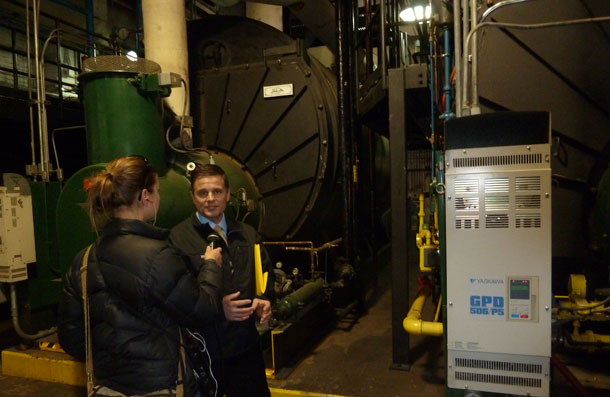
Joe Ranahan speaks with Living on Earth's Bobby Bascomb in Northeastern’s innovative steam plant. (Photo: Steve Curwood)
RANAHAN: We’re close to our steam plant, it’s a big energy feature on our campus. We feed steam through the ground to about 70% of our buildings. We use steam on campus to heat during the winter. We use it all year round to heat water for kitchens, for student dormitories. It’s an extremely clean plant and we’re actually very proud of it.
BASCOMB: Can we go see it now?
RANAHAN: Yes, we can.
[SOUND OF STEAM POWER PLANT]
BASCOMB: It’s hot in here!
RANAHAN: It is! It’s actually good that it’s hot in here. It’s more efficient to make steam using hot air as a combustion air than it is to use cold air. You have to heat the air up to combustion temperature and if it’s already warm you have a more efficient process.
BASCOMB: So, what are we seeing here? These are some big machines!
RANAHAN: Yes, we have 6 boilers in our plant. The reason we wanted to start making our own steam was because the steam utility would send us steam but we would take the condensate, which is the water left after the useful work is taken out of the steam. We would have to throw that condensate down the drain.
It was a waste of water, a waste of heat. So we started to slowly build a steam distribution network of our own and we take that condensate back to our steam plant and take that hot water and re-use it to make new steam. And again, we save a tremendous amount of water and again we save a tremendous amount of energy because we’re using pre-heated water to make steam again.
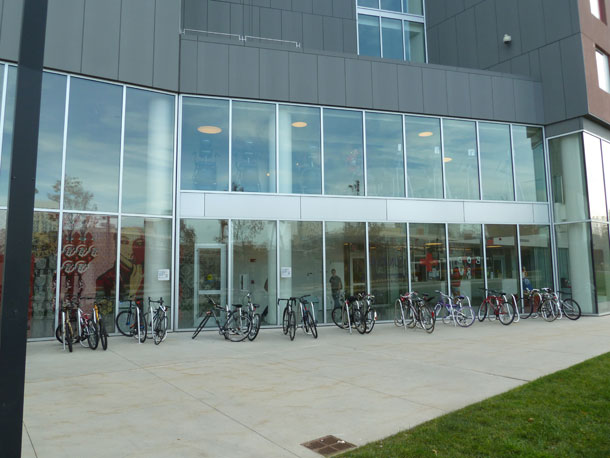
Bike's parked outside Northeastern’s LEED gold certified dormitory, International Village (Photo: Steve Curwood)
BASCOMB: Joe says these changes are saving the university several million dollars a year over what they were paying to buy steam. They are systematically looking at all the buildings to see if there are opportunities for more efficiency.
RANAHAN: One thing I hate is to see a window open in the winter because someone has a broken thermostat and the heat is stuck on.
BASCOMB: Or conversely we've all probably been in an office somewhere in the summertime where you wish you had a sweater.
RANAHAN: Right, right, and I mean, there's no need for that.
BASCOMB: Since 2005, building energy consumption on Northeastern University campus has fallen by roughly 21% but Ranahan says they’re not done yet. There’s a continual energy audit for each of the roughly 70 buildings on campus.
RANAHAN: It's sort of like painting the Brooklyn Bridge, where by the time we get to the last one it'll be time to start the first one again.
[CAMPUS SOUNDS]
BASCOMB: Joe Ranahan is especially excited about the new construction on campus. Northeastern University’s newest building, International Village, is just three years old and LEED gold certified.
RANAHAN: So, this is the front vestibule of International Village and the feature that we're looking at in this space is the daylight harvesting. There’s large glass windows, which let in plenty of light when the sun is out. So, there are sensors on the roof that sense that light and when it's bright enough in this space it turns all the lights off automatically.
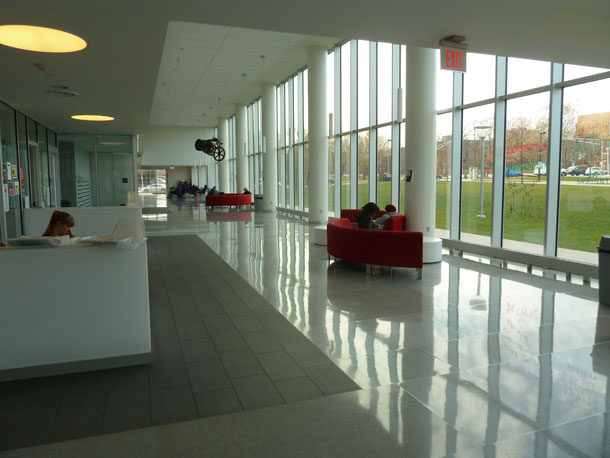
Large windows inside Northeastern’s International Village allow sunlight inside and reduce the need for electricity. (Photo: Steve Curwood)
BASCOMB: So, where are we off to next?
RANAHAN: I think we’ll head up to the green roof, which is the next floor up.
[SOUNDS OF WALKING UP THE STAIRS]
RANAHAN: This is the first building that we decided to look at these… these are motion controlled stairwell lights. What these do is they dim the lights down to the code safety level but when someone comes walking up the stairs they'll turn on to full brightness so that they can see. It makes sense; why waste the power if nobody’s using it? But we still maintain the safety code.
[SOUND OF DOOR CLOSING, TREADMILL SOUNDS]
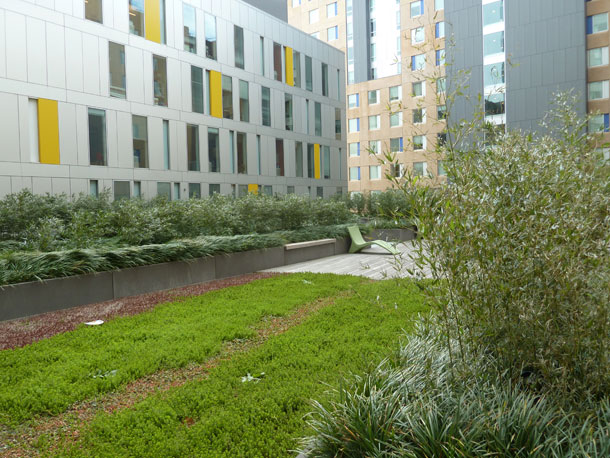
Vegetation on the roof reduces water run off during storms. (Photo: Steve Curwood)
BASCOMB: We leave the hallway and enter a gym with runners working out on a treadmill. Large glass doors open up to the roof of the cafeteria. But this roof looks more like a park. It has vegetated areas that absorb water run-off and bamboo plantings to provide shade in the summer.
RANAHAN: It's a beautiful place to sit.
BASCOMB: So was there a reason to put this in other than aesthetics?
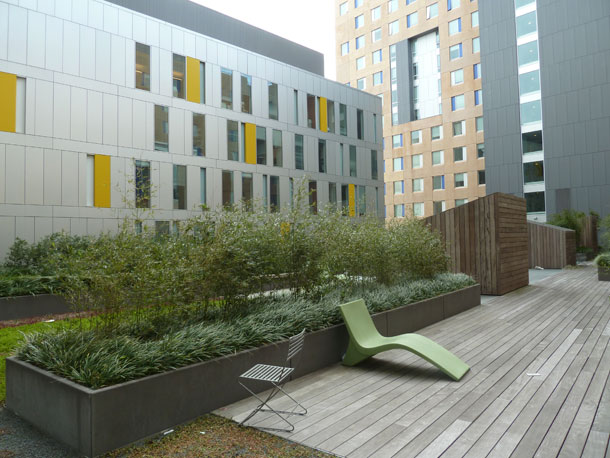
The green roof at International Village. (Photo: Steve Curwood)
RANAHAN: Well, it does act as insulation on the roof below. In addition to that we have natural lighting for the cafeterias. If you look to my right, you’ll see two… what look like sheds. They're actually skylights which light the service area downstairs.
[ELEVATOR BEEPS “GOING UP” ]
BASCOMB: Even the elevators here got an environmental upgrade.
RANAHAN: Elevators are kind of a forgotten thing in any building. When we first took over the building I got into the elevator and the first thing I noticed was incandescent light bulbs. I said, we can’t have incandescent light bulbs in an elevator! They’re on 24/7 and they’re the least efficient type of light.
BASCOMB: So, the University worked with the utility, Nstar to install LED lights in the elevators. By replacing incandescents with LEDs Northeastern saves roughly 41,000 kilowatt hours a year and roughly $5,000.
[CAFETERIA SOUNDS]
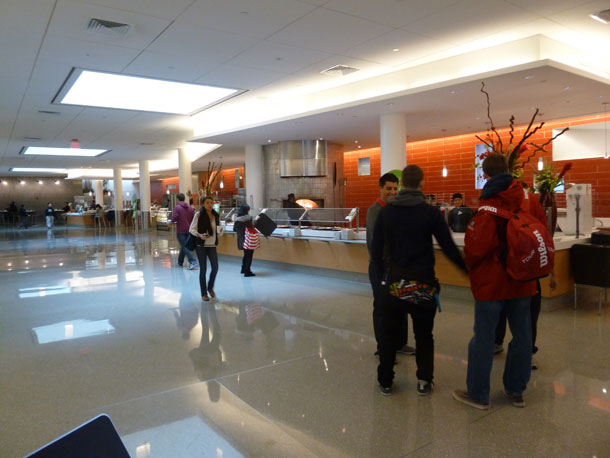
The cafeteria at Northeastern University’s International Village. (Steve Curwood)
BASCOMB: It’s close to lunchtime and Joe Ranahan is eager to show the cafeteria in International Village. It’s bright with lots of natural light. It offers organic and vegan options and sources the food from local farms as much as possible. They compost six to 700 tons of food waste each year and send it back to farms for fertilizer.
RANAHAN: This cafeteria has the distinction of being the first Green Restaurant Association's green rated cafeteria that's in a LEED gold-rated building. It sounds like you're trying to shoe horn yourself into an award but it's actually a nice award to have.
[FOOTSTEPS ON STAIRS]
BASCOMB: It’s a long climb to the top of the Curry student center where 90 solar panels were installed back in 1994 as an experiment. They still produce power but the math doesn’t make sense on a large scale.
RANAHAN: You look at this whole roof filled with solar panels and it produces maybe three percent of the power for this building. I mean, if I wanted to power this whole building I’d need to cover all of these roofs with solar panels.
BASCOMB: Just to power this one building?
RANAHAN: Just to power this one building. In a space-constrained area like an urban school we don’t have the space to put a large utility-sized array onto campus.
BASCOMB: Ranahan says efficiency is the way to go.
RANAHAN: The way that we look at it, you could generate clean power but then use it inefficiently or you could use less power through more efficient means. Either way the net effect is that you are creating less emissions.
BASCOMB: Northeastern has a relatively small endowment to make upgrades to the university, so they’ve made the conscious choice to save money by going green. In the last five years the school has reduced its power use by nearly 10.7 million kilowatt hours annually, saving the school nearly $1.3 million a year. Sam Solomon is the Northeastern University treasurer.
SOLOMON: Well I know that our overall utility cost has been able to remain stable or go down over recent years, even though obviously the overall campus has gotten larger and the overall footprint and square footage has gotten bigger. So, whether you can tie it to the new windows or to other energy saving features, we're obviously doing something right.
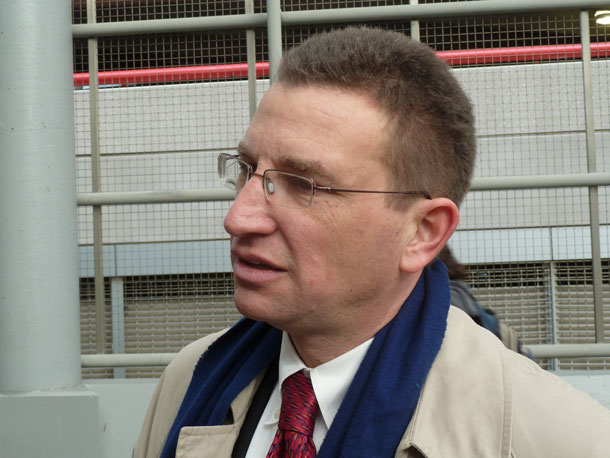
Sam Solomon is the treasurer and director of finance of Northeastern University. (Photo: Steve Curwood)
BASCOMB: Northeastern expects to be around for a long time so they feel they can afford to wait for dividends from energy efficiency investments.
SOLOMON: In the long run we look at any project we do on a cost-benefit analysis and anything with a reasonable payback period it's worth making the investment, even if it takes a couple years to get the money back.
BASCOMB: Northeastern is not alone when it comes to investing in sustainability.
THOMASHOW: I think we’re in the early days of a spectacular trend.
BASCOMB: Mitchell Thomashow is president emeritus of Unity College in Maine and a consultant to colleges and universities on sustainability issues.
THOMASHOW: If you look at all the sustainability initiatives that are taking place now in colleges and universities, it’s absolutely mind-boggling compared to what we were seeing, let’s say, at the end of the 1990s or early 2000s.
BASCOMB: Thomashow says colleges and universities across the country are experimenting with a wide range of innovations that work for them. In congested Boston, solar panels don’t make sense for Northeastern but in wide open and sunny Arizona that math works out differently.
THOMASHOW: Visit Arizona State University and you’ll see solar panels on the football stadium, you’ll see them on the parking lots. There are schools that are focusing on wind. The University of Minnesota put a whole bunch of windmills in. And then there are small colleges. Unity College, where I was president, has a tremendous focus on sustainability. We built the first LEED platinum president’s residence in the country. So we can go on and on and on. The list is just enormous.
BASCOMB: More than 700 colleges and universities in the US have signed pledges to reach carbon neutrality. They serve nearly 40 percent of the students nationally and Thomashow says these institutions are setting a good example for the students they educate.
THOMASHOW: When the campus models sustainability initiatives it sends a terrific message to the students; it says yes, life can be lived this way. You can think about this for your home or whatever business you’re going to work for.
[CAMPUS SOUNDS]
BASCOMB: Back at Northeastern University, Joe Ranahan says he takes a lot of satisfaction in the work he and his colleagues are doing here, especially since Ranahan is himself a graduate of Northeastern.
RANAHAN: We've saved the university millions and millions of dollars, millions and millions of kilowatt hours and carbon emissions.
BASCOMB: I should think too you must feel pretty good going to bed at night knowing you're saving energy and saving your alma mater all this money.
RANAHAN: I do. I drive my son crazy at home because I preach the same thing at home. I mean, it's really ingrained in me. It doesn't make any sense to waste resources when you don't need to. That's what it all comes down to, it’s whether you want to waste something or save it for the next generation, and I prefer not to waste it.
BASCOMB: Joe Ranahan, teaching his son how to conserve energy at home and putting the lessons into practice as energy manager at Northeastern University in Boston. For Living on Earth, I'm Bobby Bascomb.
Related links:
- Sustainability at Northeastern University
- UI GreenMetric World University Ranking
[MUSIC: Various Artists/Michael Franti “Stay Human (Stereo Steambath Remix)” from Traveler ’02 (Six Degrees Records 2002).]
The Place Where You Live

Mount Tamalpais, rising half a mile from the sea across the Bay. Rosie used to rivet together a warship a month during the Second World War, but her old shipyard is now a container port and the old naval fuel depot has become a Chevron refinery. (Wong Yoo-Chong)
CURWOOD: This week we have another in the Living on Earth/Orion Magazine series “The Place Where You Live.” For more than a decade, Orion has invited readers to put their memories of home on a map and submit essays on their website. And now, we’re giving them a voice.
[MUSIC: Edward Sharpe & The Magentic Zeroes “Home” from Edward Sharpe and The Magnetic Zeroes (Rough Trade Records 2009)]
CURWOOD: Our writer today was born half a world away - but for forty years he's turned his eyes to the green hills of California for solace and help.
YOO-CHONG: My name is Wong Yoo-Chong, I live in Berkeley, California. I have been working on a translation of the Lao-Tse for the past four years. And I’m about halfway done. I never come down from these hills without some insights, some epiphanies from the work on my desk. Once I leave it, I get new angles and new insights, so going up to these hills is a very crucial part of my writing.
CURWOOD: It's not just the philosophy of Lao-Tse that inspires Wong Yoo-Chong. Before he read his essay he shared a poem by the eighth century Chinese poet, Li Po titled, "Answering the Common People from the Mountains."

Winter clouds drift by to keep these grazing hills green and the reservoirs full in order to collect enough to quench the thirst of millions. In the horizon, just beyond the verdant landscape, suburbs begin again. (Wong Yoo-Chong)
YOO-CHONG: (In Chinese, then English): Asked why I live in these green hills,
I smile and do not answer; my heart is naturally calm.
Peach blossoms riding a stream vanish in mystery,
Another world, not the human realm.
[MUSIC: Nguyen Le’ “Are You Experienced” from Purple: Celebrating Jimi Hendrix (ACT Music 2012).]
YOO-CHONG: My green hills are the Berkeley Hills. These hills run parallel to the coast and fault lines, in a northwesterly direction. They have been jolted into their present form by tectonic upheaval of the earth’s crust. The famous San Andreas Fault runs under the ocean beyond the Golden Gate, but a mile away, the Hayward Fault knifes through houses and streets. It last shook in 1868.
An hour’s walk from my door is Wildcat Peak, where Nike missiles stood guard against Russian Migs and bombers. Also gone are the Ohlone and Miwok, the indigenous people who once inhabited these hills.
Walking here for forty years, I’ve enjoyed the sound of crunching leaves and bird chorus. I’ve met kestrels, crows, deer, foxes, and white-tailed rabbits. From these hills I can see the City high-rises in the western sky; in the east are ranch homes on half-acre lots along the Calaveras Fault. Looking down, I often find rattlers or gopher snakes in my path. Looking up I see circling red-tailed hawks, turkey vultures and migrating geese in huge V’s. Up in these hills is a different world.

An afternoon sun arches over San Francisco, as a blimp floats by on an NFL Sunday. The tortoise shell shaped hill in the middle is Yerba Buena Island, from which the old east span of the Bay Bridge is being replaced after a part of it collapsed in a 1998 quake. In the foreground is the silhouette of a ridge of the Berkeley Hills. (Wong Yoo-Chong)
CURWOOD: That's Wong Yoo-Chong. And we want to hear about “The Place Where You Live.” To find out how to submit your essay for the Orion Magazine/Living on Earth series, visit our website LOE dot org.
Related link:
Mr. Wong’s Original Essay in Orion Magazine’s The Place Where You Live
[MUSIC CONTINUES]
CURWOOD: We leave you this week with a slightly different kind of Earth Ear - an Inuit Throat Song called The River.
[THROAT SONG]
CURWOOD: Even the rivers feel the short urgency of the Arctic Summer - as they tumble over the tundra.
[THROAT SONG CONTINUES]
CURWOOD: That's reflected in this song, by Karen Panigoniak and Maria Illungiayok.

(Photo: © Mark Seth Lender)

(Photo: © Mark Seth Lender)

(Photo: © Mark Seth Lender)
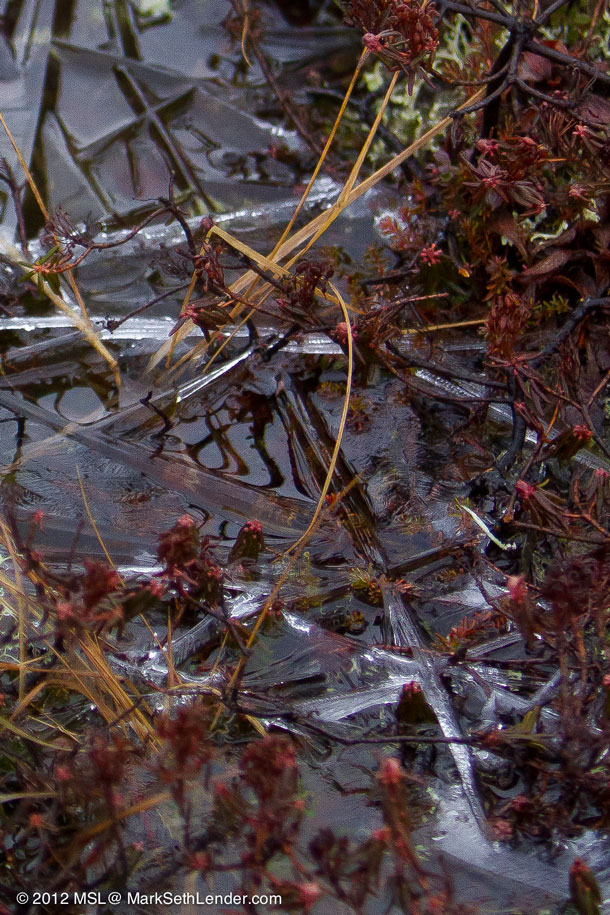
(Photo: © Mark Seth Lender)
Writer Mark Seth Lender recorded it in the traditional community of Arviat. There are some of Mark’s arctic photos, at our website, LOE dot org.
[SOUNDS: From: http://www.youtube.com/aryaut with the help of Mike Robbins.]
[Credits: Karen Panigoniak, Mark Seth Lender and special thanks to Mike Robbins]
CURWOOD: Living on Earth is produced by the World Media Foundation. Bobby Bascomb, Emmett Fitzgerald, Helen Palmer, Annie Sneed, James Curwood, Meghan Miner, and Gabriela Romanow all help to make our show. Jeff Turton is our technical director. Alison Lirish Dean composed our themes. You can find us anytime at L-O-E dot org - and check out our facebook page - it’s PRI’s Living on Earth. I'm Steve Curwood. Thanks for listening!
ANNOUNCER: Funding for Living on Earth comes from Stonyfield Farm, makers of organic yogurt, smoothies, and more. Stonyfield invites you to just eat organic for a day. Details at just eat organic dot com. Support also comes from you, our listeners. The Go Forward Fund and Pax World Mutual and Exchange Traded Funds. Integrating environmental, social, and governance factors into investment analysis and decision making. On the web at Pax World dot com.
ANNOUNCER 2: PRI Public Radio International.
Living on Earth wants to hear from you!
Living on Earth
62 Calef Highway, Suite 212
Lee, NH 03861
Telephone: 617-287-4121
E-mail: comments@loe.org
Newsletter [Click here]
Donate to Living on Earth!
Living on Earth is an independent media program and relies entirely on contributions from listeners and institutions supporting public service. Please donate now to preserve an independent environmental voice.
NewsletterLiving on Earth offers a weekly delivery of the show's rundown to your mailbox. Sign up for our newsletter today!
 Sailors For The Sea: Be the change you want to sea.
Sailors For The Sea: Be the change you want to sea.
 Creating positive outcomes for future generations.
Creating positive outcomes for future generations.
 Innovating to make the world a better, more sustainable place to live. Listen to the race to 9 billion
Innovating to make the world a better, more sustainable place to live. Listen to the race to 9 billion
 The Grantham Foundation for the Protection of the Environment: Committed to protecting and improving the health of the global environment.
The Grantham Foundation for the Protection of the Environment: Committed to protecting and improving the health of the global environment.
 Contribute to Living on Earth and receive, as our gift to you, an archival print of one of Mark Seth Lender's extraordinary wildlife photographs. Follow the link to see Mark's current collection of photographs.
Contribute to Living on Earth and receive, as our gift to you, an archival print of one of Mark Seth Lender's extraordinary wildlife photographs. Follow the link to see Mark's current collection of photographs.
 Buy a signed copy of Mark Seth Lender's book Smeagull the Seagull & support Living on Earth
Buy a signed copy of Mark Seth Lender's book Smeagull the Seagull & support Living on Earth

